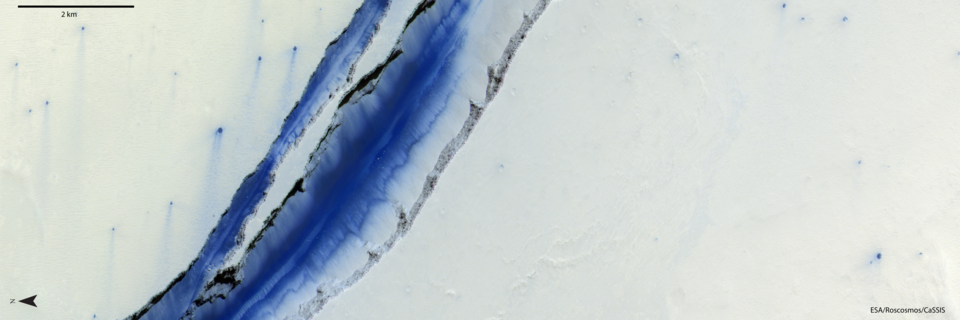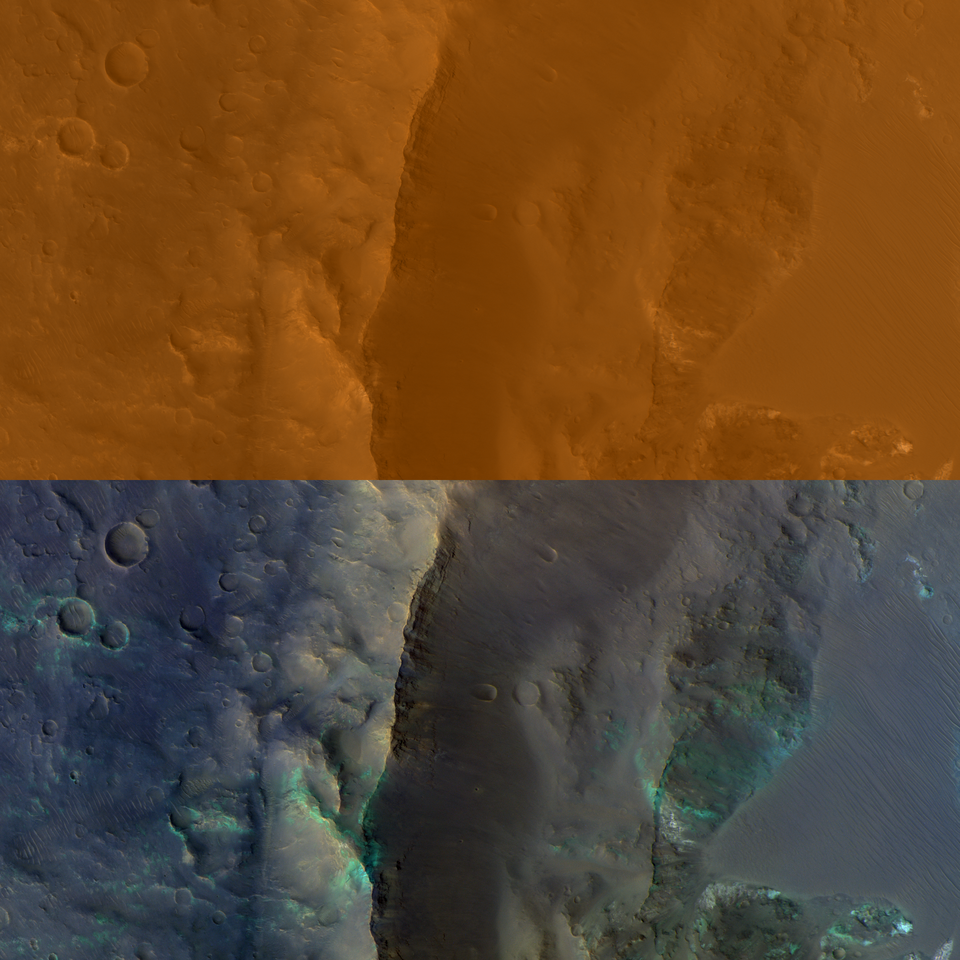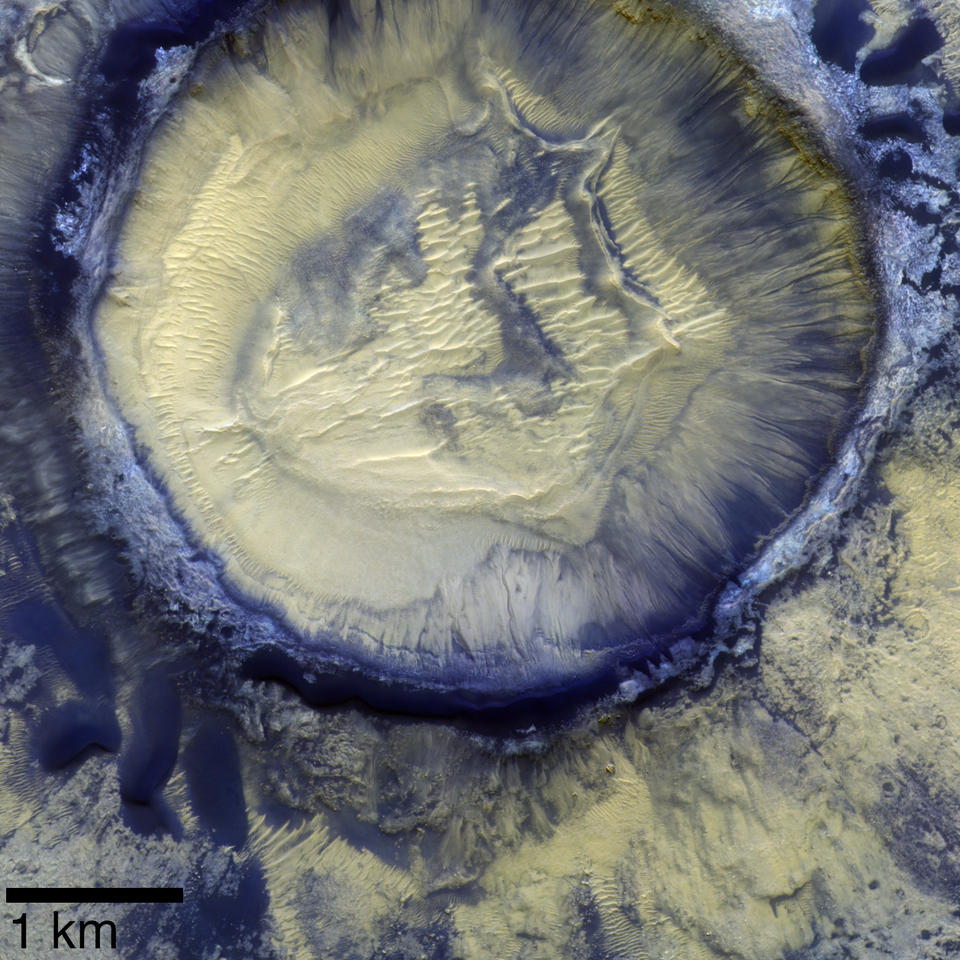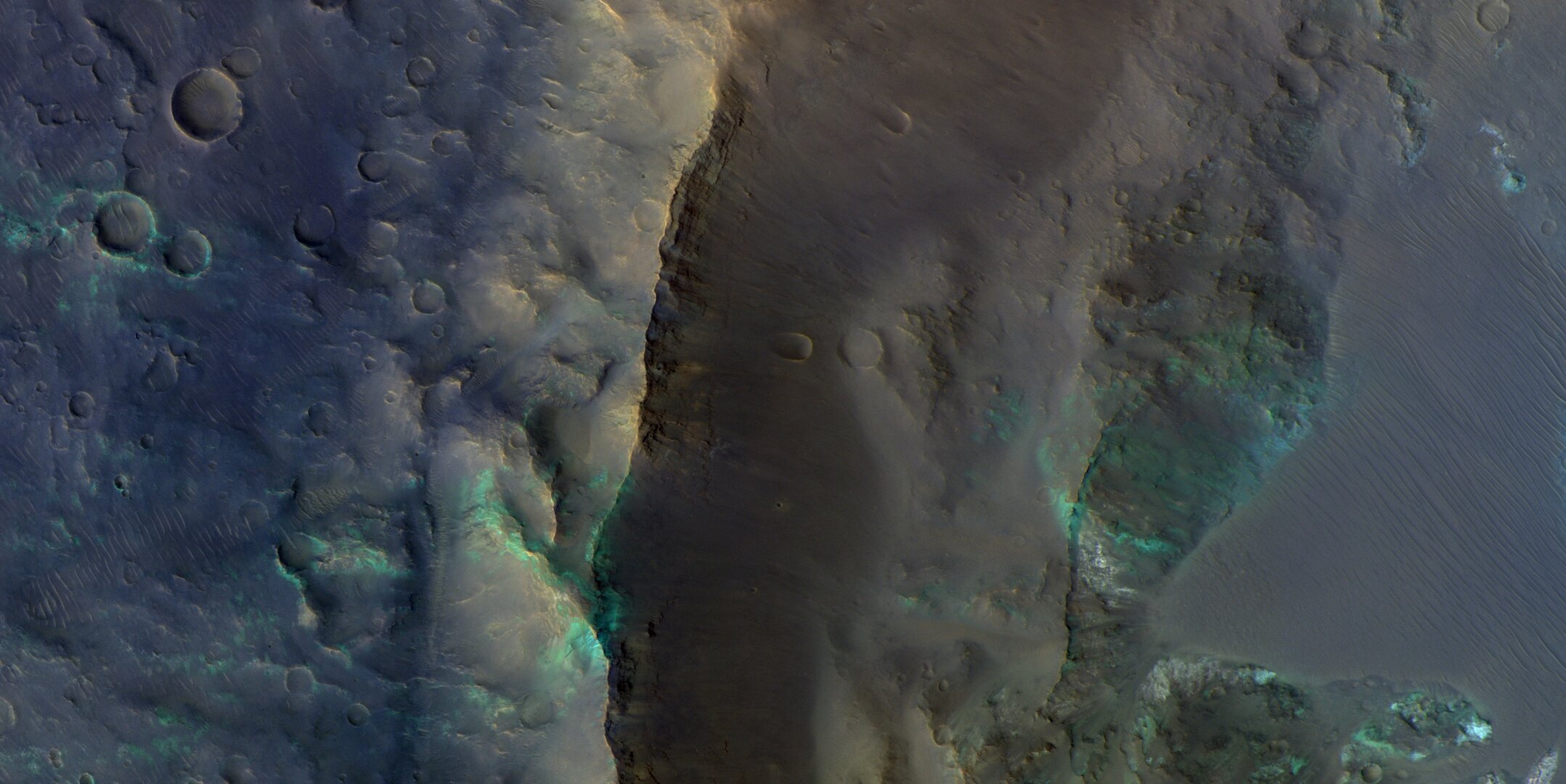Red Mars, blue Mars: through the eye of a Mars-orbiting camera
To the human eye Mars appears red, but the European Colour and Stereo Surface Imaging System (CaSSIS) onboard the ExoMars Trace Gas Orbiter reveals a striking diversity of colour. Its blue-hued images are arguably some of the most eye-catching and surprising outputs. Processing images in this way is not just for wow-factor, though, but for digging deeper into the geology of Mars than ever before – all from orbit.
Every shade of red
Mars is known as the Red Planet for a reason. Even its white seasonal ices at the polar caps often have a slightly red tinge because of the red martian dust that gets deposited with the ice during polar winters. And there is certainly an extraordinary diversity in the numerous shades of reds as seen from orbiters over large scales, and at local scales by rovers exploring the martian surface.
These shades of red correspond to what we would see if we were hiking through the martian terrain, using our eyes or taking snapshots with a regular smartphone. Nice examples of this can be seen from the Curiosity rover. Filters in smartphones are used to mimic the response of the human eye to produce an accurate rendition of what you see. Images are output in the Red-Green-Blue (RGB) system allowing millions of different individual brightnesses and colours to be represented.

But technology gives us a gift: we do not necessarily have to look at the world – or in this case, Mars – at wavelengths that only correspond to the response of the human eye. Our eyes can detect wavelengths of about 400–710 nm, while most commercial and scientific camera systems using silicon-based detectors are also sensitive to wavelengths into the infrared beyond 700 up to 1100 nm, doubling the spectral range and allowing us to image objects in a new light. Furthermore, scientific cameras do not necessarily have to follow the RGB system. When designing a camera for a spacecraft mission to another planet, specific filters can be selected to maximize the spectral differences of the surfaces to be observed.
Making the invisible visible
TGO’s CaSSIS camera builds on the colour capability of the HiRISE instrument on NASA’s Mars Reconnaissance Orbiter (MRO), which was designed with three filters: blue-green, red, and one in the near-infrared looking at wavelengths invisible to the human eye. This works well because the surface of Mars is rich in iron oxides and minerals that show varying degrees of absorption of sunlight in the 800–1100 nm range.
When it was time to design the CaSSIS filter set, the teams recognized they could add a fourth filter. Thus, CaSSIS copies the HiRISE blue-green and red filters but splits the near-infrared filter into two to get even more information on the spectral diversity in this invisible-to-humans wavelength range. This large spectral range uses twice as large a wavelength range as what human eyes can see. The CaSSIS images that you can see on this page and in other image releases reveal the results of this choice.

The images most often presented by the CaSSIS team are the so-called ‘NPB’ product. This puts the near-infrared filter (NIR, N) covering the longest wavelengths in the red channel of the display, the panchromatic filter (PAN, P) in the green channel, and the blue filter (BLU, B) in the blue channel. In addition, each filter image is ‘stretched’, meaning that the image is re-scaled between the minimum and maximum brightness within each colour before combining them to produce the published image.
Beautiful diversity
To illustrate the process, here (below right – top image) is a CaSSIS image processed to look a bit more like what a human would see, by stretching each filter using the same minimum and maximum pixel values assigned to black and white, rather than stretching them differently as we do with the NPB product.

This produces an image that approximates how your eye would see this scene if you were sitting on the spacecraft with a pair of (very strong!) binoculars. Because CaSSIS doesn’t have the same red, green, and blue filters as a smartphone camera and is sensitive to infrared light invisible to humans, the shade of red is slightly different from what you would see with your eyes, appearing more orange. Next to this image is the same scene in the NPB product. Although you can see small colour difference in the pseudo-RGB product, the NPB product really brings out the diversity of this surface.
The whole approach is designed to bring out the colour diversity on the surface of Mars to the maximum extent possible. This processing accentuates the fact that Mars is much more diverse than we had imagined. This naturally yields incredibly pleasing images that can be enjoyed by non-experts. Scientifically, it has a very important purpose. It allows scientists to observe changes across the surface at high spatial resolution, to identify geological units more clearly, and to better understand the stratigraphy (and therefore the geological history) of key areas on Mars. This information is crucial in understanding the evolution of Mars.
Is Mars really blue?

In many CaSSIS images we see striking blue colours. Is Mars secretly blue?! Martian sands are relatively bluer than the bedrock, but most would still appear reddish to the human eye. Their vibrant blue colour in CaSSIS imagery is a result of the processing technique used to highlight subtle variations of surface mineralogy
And are there areas where Mars has no colour diversity? At the level that CaSSIS can distinguish colours, yes! Large parts of the huge volcanic construct on Mars called Tharsis are uniform in colour according to CaSSIS. This is because the coverage by dust of volcanic origin is highly uniform in this area and it masks the colour of the surface beneath it.
In the meantime, enjoy the latest beautifully colour-diverse images of Mars from CaSSIS here.















 Germany
Germany
 Austria
Austria
 Belgium
Belgium
 Denmark
Denmark
 Spain
Spain
 Estonia
Estonia
 Finland
Finland
 France
France
 Greece
Greece
 Hungary
Hungary
 Ireland
Ireland
 Italy
Italy
 Luxembourg
Luxembourg
 Norway
Norway
 The Netherlands
The Netherlands
 Poland
Poland
 Portugal
Portugal
 Czechia
Czechia
 Romania
Romania
 United Kingdom
United Kingdom
 Slovenia
Slovenia
 Sweden
Sweden
 Switzerland
Switzerland


























